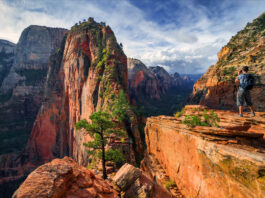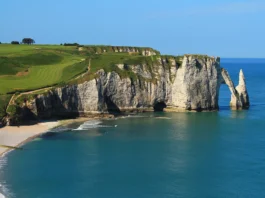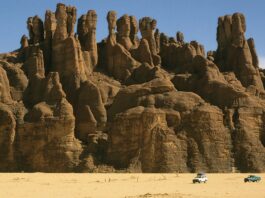Horseshoe Bend is a breathtaking natural feature located in the United States. It is situated near the town of Page, Arizona, and is a popular tourist destination due to its stunning geological formations and picturesque beauty.



Horseshoe Bend is an incised meander of the Colorado River. Over millions of years, the flowing water of the river has carved out a deep and dramatic horseshoe-shaped curve in the sandstone. The overlook at Horseshoe Bend provides visitors with a mesmerizing panoramic view of the meandering river below and the towering cliffs that surround it.
The rock formations at Horseshoe Bend are predominantly composed of Navajo Sandstone, which is known for its vibrant hues of red, orange, and yellow. The layers of sedimentary rock reveal a rich geological history that spans millions of years. The varying colors and textures in the sandstone create a visually striking display, particularly during sunrise and sunset when the light casts a warm glow on the landscape.
Beyond its geological significance, Horseshoe Bend also holds cultural and historical importance. The area is part of the ancestral lands of the Native American tribes, including the Navajo, Hopi, and others. These tribes have inhabited the region for centuries, and their connection to the land adds an additional layer of significance to Horseshoe Bend.
Due to its immense natural beauty and accessibility, Horseshoe Bend has become a popular subject for geologic art. Artists have captured its stunning vistas through various mediums, including paintings, drawings, and photography. The vibrant colors of the sandstone cliffs and the contrasting blue waters of the Colorado River provide endless inspiration for artistic interpretations of this geological wonder.
Overall, Horseshoe Bend in the United States is a captivating destination that combines geological marvels with artistic inspiration. Its unique formation, geological history, and stunning beauty make it a must-see landmark for both nature enthusiasts and art lovers alike.
Contents
Formation of Horseshoe Bend
The formation of Horseshoe Bend can be attributed to the erosive power of the Colorado River combined with the underlying geology of the region.
Around 5 to 6 million years ago, the Colorado River began cutting through the Colorado Plateau, gradually eroding the rock layers and shaping the landscape. The river’s path was influenced by the underlying geology, particularly the resistance of different rock layers to erosion.
Horseshoe Bend is located in an area dominated by Navajo Sandstone, a soft and easily erodible rock formation. As the Colorado River flowed through this region, it encountered alternating layers of harder and softer rocks. The softer Navajo Sandstone eroded more quickly, while the harder layers, such as the Kayenta Formation and the Wingate Sandstone, offered more resistance to erosion.
The erosive power of the river, combined with the differential erosion of the rock layers, led to the formation of a meander. Meanders are sinuous bends or loops that develop as a river winds its way across a relatively flat landscape. Over time, the Colorado River carved out a deep and dramatic horseshoe-shaped bend in the Navajo Sandstone, creating what is now known as Horseshoe Bend.
The unique shape of Horseshoe Bend is a result of the river’s meandering path and the resistance of the underlying rock layers. The outer bank of the meander experiences faster flow and greater erosion, while the inner bank experiences slower flow and deposition of sediment. This differential erosion and deposition contribute to the characteristic shape of a horseshoe.
It’s important to note that the formation of Horseshoe Bend is an ongoing process. The Colorado River continues to shape and modify the landscape, albeit at a much slower rate than in the past. The erosive forces of water and time are constantly at work, subtly altering the contours of this remarkable geological feature.
Colorado Plateau
The Colorado Plateau is a vast and unique geographic region located in the western United States. It covers parts of several states, including Utah, Colorado, Arizona, and New Mexico. The plateau is characterized by its elevated, flat-topped mesas, deep canyons, and stunning geological formations.
Geologically, the Colorado Plateau is primarily composed of sedimentary rock layers that have been uplifted and exposed over millions of years. These rock layers were deposited during different geological periods, ranging from the Paleozoic Era to the Cenozoic Era, and they contain a wealth of information about the Earth’s history.
The most prominent rock formation on the Colorado Plateau is the Navajo Sandstone, which is famous for its striking red and orange hues. This formation was created during the Jurassic Period, approximately 180 million years ago, when large sand dunes accumulated in a vast desert environment. Other notable formations include the Wingate Sandstone, Kayenta Formation, and Chinle Formation, each representing different geological periods and environments.
The Colorado Plateau is also home to several iconic natural landmarks and national parks, including the Grand Canyon, Zion National Park, Bryce Canyon National Park, Arches National Park, and Canyonlands National Park. These protected areas showcase the region’s stunning landscapes, breathtaking canyons, and unique rock formations, attracting millions of visitors each year.
The Colorado River and its tributaries have played a significant role in shaping the Colorado Plateau’s topography. Over millions of years, the river and its erosive power have carved deep canyons, including the Grand Canyon, and created intricate networks of tributaries and drainage systems.
In addition to its geological significance, the Colorado Plateau holds cultural and historical importance. It has been home to Native American tribes for thousands of years, including the Navajo, Hopi, Ute, and others. These tribes have a deep connection to the land and have left a rich cultural legacy in the form of rock art, cliff dwellings, and ancestral sites.
The Colorado Plateau is a haven for outdoor enthusiasts, geologists, and nature lovers. Its unique geological formations, diverse ecosystems, and rich cultural heritage make it a captivating region to explore and study. It is a testament to the forces of nature and the incredible beauty that can emerge from millions of years of geological processes.
Navajo Sandstone is a prominent rock formation found in the southwestern United States, particularly in the Colorado Plateau region. It is renowned for its vibrant red, orange, and tan hues, which give the landscape a striking and picturesque appearance.
Geological studies estimate that the Navajo Sandstone was deposited during the Jurassic Period, approximately 180 million years ago. At that time, the area now known as the Colorado Plateau was a vast desert region, characterized by large sand dunes. Over time, the accumulation of wind-blown sand grains formed the Navajo Sandstone.
The Navajo Sandstone is primarily composed of well-cemented, fine-grained sand particles, which give it its characteristic texture. The sand grains are primarily composed of quartz, with smaller amounts of feldspar, lithic fragments, and other minerals. The iron oxide minerals present in the sand grains, such as hematite and goethite, contribute to the vibrant red and orange colors of the rock.
This formation covers a vast area and can be found in numerous national parks and landmarks, including Zion National Park, Capitol Reef National Park, Arches National Park, and the Valley of Fire State Park. The unique erosional patterns of the Navajo Sandstone have created stunning features, such as towering cliffs, deep canyons, and delicate rock arches.
The Navajo Sandstone not only showcases its remarkable visual appeal but also holds geological significance. The rock layers often exhibit cross-bedding structures, indicating the ancient wind patterns that shaped the sand dunes. Fossils are relatively rare in the Navajo Sandstone due to its desert origin, but occasional tracks and traces of ancient animals have been discovered.
The durability and resistance of the Navajo Sandstone to weathering have contributed to the creation of iconic geological formations in the region. Delicate Arch in Arches National Park and the towering cliffs of Zion Canyon are just a few examples of the stunning features sculpted by erosion in the Navajo Sandstone.
The Navajo Sandstone not only represents a significant geological formation but also serves as a testament to the natural beauty and geological history of the Colorado Plateau. Its colorful and awe-inspiring landscapes continue to attract visitors from around the world, offering a glimpse into the ancient desert environments that once dominated the region.
Geological Time Scale of Horseshoe Bend
Horseshoe Bend, located in the United States near Page, Arizona, is a geological feature that formed within the context of a much larger geological time scale. To understand the geological history of Horseshoe Bend, we need to consider the broader time scale known as the Geologic Time Scale.
The Geologic Time Scale is a framework used by geologists to divide Earth’s history into distinct intervals based on major geological and biological events. It is divided into eons, eras, periods, epochs, and ages.
Horseshoe Bend is part of the Colorado River system, which has been shaping the landscape for millions of years. However, Horseshoe Bend itself is a relatively young feature compared to the broader time scale. It is estimated to have formed within the past several million years.
Horseshoe Bend is located in the Colorado Plateau region, which primarily consists of sedimentary rocks. The rock layers that make up Horseshoe Bend, including the Navajo Sandstone, were deposited during the Jurassic Period, approximately 180 million years ago.
The Colorado River began carving its path through the Colorado Plateau around 5 to 6 million years ago. Over time, the river’s erosive power and the differential erosion of the rock layers shaped the deep, horseshoe-shaped bend we see today.
It’s important to note that while Horseshoe Bend itself is a relatively recent formation in the context of the Geologic Time Scale, the broader geological history of the region spans hundreds of millions of years. The rock layers underlying Horseshoe Bend contain a record of ancient environments, including deserts, shallow seas, and ancient river systems, representing a much longer geological time scale.
So, while Horseshoe Bend may be a young feature within the geological context, it offers a glimpse into the dynamic processes that have shaped the Colorado Plateau over hundreds of millions of years.
Access
Horseshoe Bend is a popular tourist destination and is easily accessible for visitors. Here is some information on accessing Horseshoe Bend:
Location: Horseshoe Bend is located near the town of Page, Arizona, in the southwestern United States.
Getting There:
- By Air: The closest major airport to Horseshoe Bend is Page Municipal Airport (PGA), which offers limited commercial flights. Alternatively, you can fly into larger airports such as Phoenix Sky Harbor International Airport (PHX) or Las Vegas McCarran International Airport (LAS), both of which are a few hours’ drive away from Horseshoe Bend.
- By Car: Horseshoe Bend is accessible by car. From Page, Arizona, you can reach Horseshoe Bend by driving about 7 miles south on U.S. Route 89. There is a large parking lot available near the Horseshoe Bend Overlook, where visitors can park their vehicles.
Visiting Horseshoe Bend:
- Hiking: To reach the Horseshoe Bend Overlook, visitors need to hike from the parking lot. It’s approximately a 0.75-mile (1.2 kilometers) hike from the parking area to the viewpoint. The trail is well-marked and maintained, but be prepared for some sandy and uneven terrain. The hike is relatively easy, but make sure to bring water, wear comfortable shoes, and use sunscreen, especially during hot weather.
- Viewing Area: The Horseshoe Bend Overlook offers a stunning view of the horseshoe-shaped curve of the Colorado River. There is no fence or guardrail at the viewpoint, so exercise caution and stay away from the edge for safety.
- Admission and Hours: There is an admission fee to access the Horseshoe Bend Overlook. As of my knowledge cutoff in September 2021, the fee was $10 per vehicle or $5 per person for pedestrians and cyclists. However, please note that fees and hours of operation may change, so it’s advisable to check the official website or contact local authorities for the most up-to-date information.
It’s important to remember that Horseshoe Bend is a popular attraction, and during peak travel times, it can get crowded. To avoid large crowds, consider visiting during weekdays or less busy seasons. Additionally, always follow any posted signs and guidelines to ensure a safe and enjoyable visit.
Photography and Tourism
Photography and tourism often go hand in hand, as photography has become an integral part of the travel experience for many people. Here are some points to consider regarding the relationship between photography and tourism:
- Capturing Memories: Photography allows tourists to capture and preserve memories of their travel experiences. People can document the places they visit, the landscapes they explore, the people they meet, and the unique moments they encounter during their journey.
- Sharing Experiences: With the advent of social media and online platforms, tourists can easily share their travel photos with friends, family, and a wider audience. Sharing photos can inspire others to visit certain destinations and contribute to the promotion of tourism.
- Destination Marketing: Tourism boards, travel agencies, and businesses often use photography to promote destinations. Stunning photographs showcasing beautiful landscapes, cultural attractions, and unique experiences can entice potential tourists and help generate interest in a specific location.
- Visual Storytelling: Photography allows tourists to tell stories through visuals. Images can convey emotions, cultural aspects, and the atmosphere of a place, providing a glimpse into the travel experience that goes beyond words.
- Professional Photography: In many tourist destinations, professional photographers offer services to capture high-quality images of tourists against scenic backdrops. These services, such as portrait photography or guided photo tours, provide visitors with professionally taken photographs to commemorate their trip.
- Influence on Travel Decisions: Photos shared by other travelers, influencers, or professional photographers can have a significant impact on people’s travel decisions. Eye-catching images can inspire individuals to visit specific destinations, explore certain attractions, or engage in specific activities.
- Responsible Photography: While photography enhances tourism experiences, it is crucial to be mindful and respectful when taking photos. Respecting local customs, privacy, and the environment is essential. In certain places, there may be restrictions on photography, such as in religious sites or sensitive areas, so it’s important to adhere to any guidelines or regulations.
Photography and tourism have a symbiotic relationship, with photography enhancing the travel experience and playing a significant role in destination promotion. However, it’s important to strike a balance between capturing memories and being present in the moment, as being overly focused on photography can sometimes detract from fully enjoying the travel experience.






